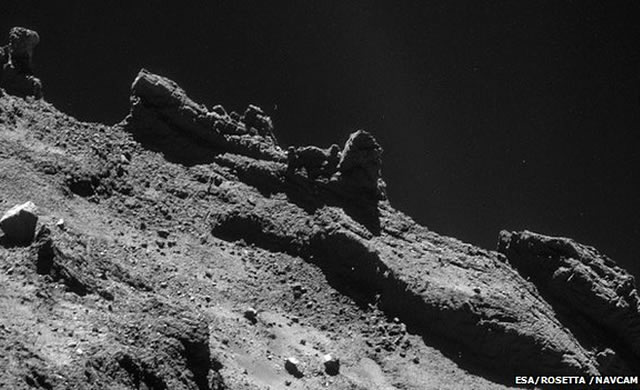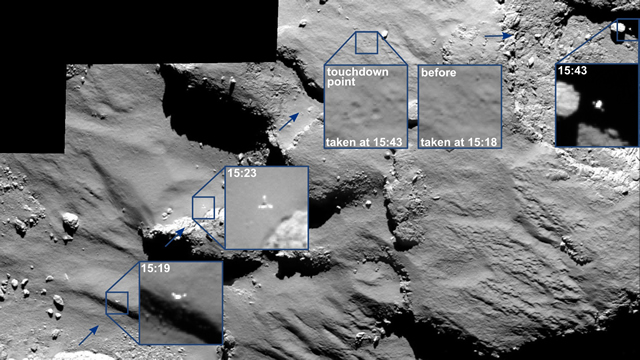
Credit: ESA
Oltre al tatto: anche molecole organiche negli altri strumenti di Philae – L’udito del lander, affidato principalmente all’orecchio di SESAME (Surface Electrical, Seismic and Acoustic Monitoring Experiment), conferma sostanzialmente quanto rilevato da MUPUS. «La resistenza del ghiaccio presente al di sotto dello strato di polvere che ricopriva il primo punto di contatto è sorprendentemente elevata», osserva Klaus Seidensticker, del DLR, riferendosi al luogo in cui Philae è rimbalzato, aggiungendo che non pare esserci molta attività cometaria nella zona del touchdown, e che sotto al lander è presente acqua ghiacciata in grande quantità. Dai due nasi di Philae, COSAC e Ptolemy, gli organi decisamente più interessanti ai fini della ricerca d’eventuali mattoncini della vita, non è ancora emersa alcuna novità rispetto al poco che già avevamo anticipato sabato scorso. Ovvero: è certo che SD2, il trapano che doveva fornire ai due laboratori chimici il campione di cometa da annusare, è stato attivato. Ed è confermato che sono stati compiuti tutti i passaggi previsti per il trasporto del campione all’interno del forno d’analisi. Ma ancora non è stato detto se il campione era davvero presente. E tanto meno si hanno risultati dalla cromatografia. Questo a piano terra, al livello del suolo.
Qualche notizia in più, invece, dalle analisi sulla rarefatta atmosfera: COSAC è stato in grado d’annusarla e d’individuarvi le prime molecole organiche. Non è però stato specificato quali, e lo studio degli spettri è ancora in corso.
Fonte/Leggi tutto → Media.Inaf.it

Before going into hibernation at 01:36 CET on 15 November 2014, the Philae lander was able to conduct some work using power supplied by its primary battery. With its 10 instruments, the mini laboratory sniffed the atmosphere, drilled, hammered and studied Comet 67P/ Churyumov-Gerasimenko while over 500 million kilometres from Earth.
After a triple landing, positioning it in a new, unplanned location, conditions were not optimal, but Philae was able to work for more than 60 hours and send the resulting data back to Earth. It was controlled and monitored from the German Aerospace Center (Deutsches Zentrum für Luft- und Raumfahrt; DLR) Lander Control Center (LCC). Now, the complicated data analysis begins. DLR’s Scientific Director for the project, Ekkehard Kührt, is very pleased with the results so far. “We have collected a great deal of valuable data, which could only have been acquired through direct contact with the comet. Together with the measurements performed by the Rosetta orbiter, we are well on our way to achieving a greater understanding of comets. Their surface properties appear to be quite different than was previously thought.” Sniffing for organic molecules.
The last of the 10 instruments on board the Philae lander to be activated was the Sampling, Drilling and Distribution (SD2) subsystem, which was designed to provide soil samples for the COSAC and PTOLEMY instruments. It is certain that the drill was activated, as were all the steps to transport the sample to the appropriate oven. COSAC also worked as planned. Now scientists need to analyse the data to determine whether a soil sample was actually examined in the gas chromatograph.
This will be done in collaboration with several instrument teams. Did CASSE hear drilling? What soil strength did MUPUS encounter when hammering? With what force was the SD2 drill used? “We currently have no information on the quantity and weight of the soil sample,” says Fred Goesmann from the Max Planck Institute for Solar System Research. However, COSAC was able to ‘sniff’ the atmosphere and detect the first organic molecules after landing. Analysis of the spectra and the identification of the molecules are continuing.
Source/Continue reading → www.dlr.de





















